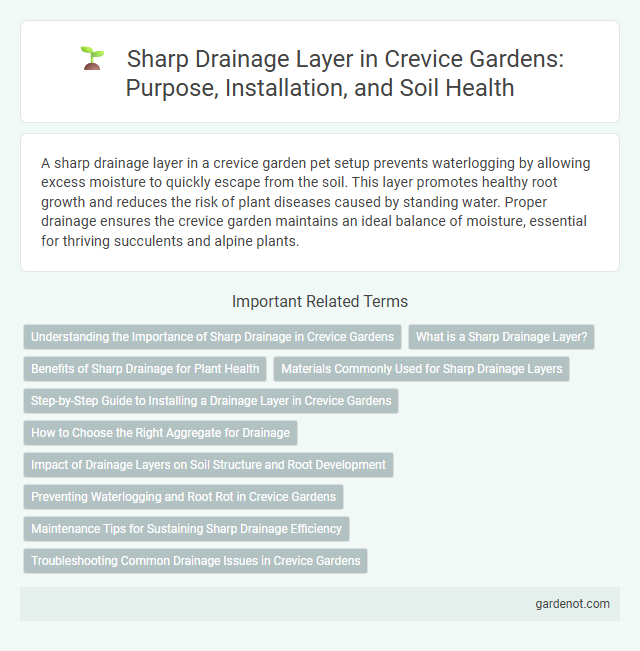A sharp drainage layer in a crevice garden pet setup prevents waterlogging by allowing excess moisture to quickly escape from the soil. This layer promotes healthy root growth and reduces the risk of plant diseases caused by standing water. Proper drainage ensures the crevice garden maintains an ideal balance of moisture, essential for thriving succulents and alpine plants.
Understanding the Importance of Sharp Drainage in Crevice Gardens
Sharp drainage in crevice gardens is essential for preventing waterlogging and promoting healthy root development in alpine and drought-tolerant plants. Utilizing coarse, angular materials such as crushed granite or grit enhances water flow and air circulation, reducing the risk of root rot and fungal diseases. Consistent sharp drainage supports the unique microenvironment of crevice gardens, ensuring plant resilience and longevity.
What is a Sharp Drainage Layer?
A sharp drainage layer in a crevice garden consists of coarse, angular materials such as crushed stone or gravel, designed to facilitate efficient water runoff and prevent root rot. This layer enhances soil aeration by creating porous spaces that allow excess water to drain quickly, supporting drought-tolerant plants typical in crevice gardens. Installing a sharp drainage layer is crucial for maintaining the garden's structural integrity and promoting healthy root development.
Benefits of Sharp Drainage for Plant Health
A sharp drainage layer in crevice gardens prevents waterlogging by facilitating rapid water flow and improving soil aeration. This enhanced drainage reduces root rot risk and promotes healthier root growth, essential for plant vitality. Proper sharp drainage also maintains optimal moisture levels, supporting nutrient absorption and overall plant resilience.
Materials Commonly Used for Sharp Drainage Layers
Sharp drainage layers in crevice gardens commonly utilize materials such as crushed granite, coarse gravel, and angular stones, chosen for their high permeability and durability. These materials facilitate efficient water flow and prevent soil compaction, essential for maintaining healthy root systems in rocky, narrow crevices. Proper selection of drainage media enhances aeration and reduces the risk of waterlogging, promoting optimal plant growth in challenging environments.
Step-by-Step Guide to Installing a Drainage Layer in Crevice Gardens
Begin the installation of a sharp drainage layer in crevice gardens by first leveling the base soil to ensure even water flow. Distribute a 2-3 inch layer of angular gravel or crushed stone with particle sizes between 10-20 mm, facilitating optimal water drainage and preventing root rot. Compact the drainage layer lightly to maintain stability, then overlay with a geotextile fabric to separate soil from gravel, preserving drainage efficiency and preventing clogging over time.
How to Choose the Right Aggregate for Drainage
Selecting the right aggregate for a sharp drainage layer in crevice gardens ensures efficient water flow and prevents root rot. Opt for coarse, angular materials like crushed granite or lava rock to create ample air pockets and promote rapid drainage. Avoid fine, rounded gravel as it can compact and reduce permeability, undermining plant health in crevice environments.
Impact of Drainage Layers on Soil Structure and Root Development
A sharp drainage layer in a crevice garden enhances soil aeration by preventing waterlogging, which promotes healthier root development and stronger plant growth. Proper drainage layers reduce soil compaction and improve nutrient uptake efficiency by maintaining an optimal balance of air and moisture around roots. This controlled environment supports diverse plant species, ensuring long-term stability and resilience of the garden ecosystem.
Preventing Waterlogging and Root Rot in Crevice Gardens
A sharp drainage layer in crevice gardens ensures rapid water dispersion, preventing waterlogging that can suffocate plant roots. Composed of coarse aggregates like grit or gravel, this layer enhances soil aeration and minimizes the risk of root rot by maintaining optimal moisture levels. Effective drainage is crucial for the health of alpine and succulent plants commonly found in crevice garden environments.
Maintenance Tips for Sustaining Sharp Drainage Efficiency
Maintaining a sharp drainage layer in crevice gardens requires regular removal of debris and organic matter to prevent clogging and ensure optimal water flow. Inspecting the drainage components seasonally allows for early detection of sediment buildup or root intrusion, which can impede drainage efficiency. Employing coarse, well-graded materials such as gravel or crushed stone enhances permeability and reduces maintenance frequency.
Troubleshooting Common Drainage Issues in Crevice Gardens
A sharp drainage layer in crevice gardens prevents waterlogging by facilitating rapid runoff and avoiding root rot. Common drainage issues arise from compacted substrates or insufficient gravel size, which reduce permeability and cause water stagnation. Regular inspection and replenishment of coarse, sharp aggregates ensure optimal drainage and healthy plant growth in crevice garden environments.
Sharp drainage layer Infographic

 gardenot.com
gardenot.com